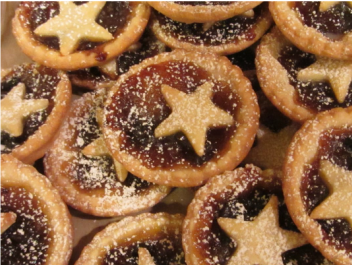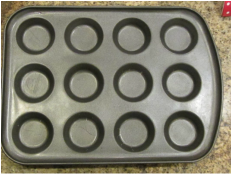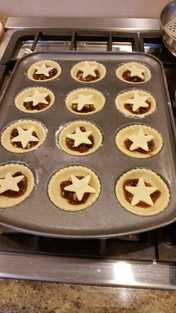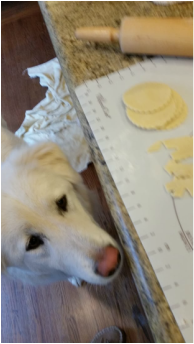 Nurture these babies carefully. Then eat them. Nurture these babies carefully. Then eat them. It’s mince pie season. Apparently there are other celebrations of some sort going on as well, but mostly, it’s mince pie season. I’ve made eighty-four mince pies and eaten about forty-eight of them. They’re going in lunch boxes, being foisted on friends, and form part of my mother-in-law’s convalescent diet after being in hospital for several weeks. Such is the power of mince pies. Okay, so we get it: I like mince pies. I like many other things about Christmas (parkin anyone? Anyone?) but there’s something about a well-made mince pie that says Crimble is a warm and happy place and we are loved. Unfortunately, in the U.S., there’s been some kind of miscommunication. The mince pies you find in the stores here labor under the impression that they should be plate-sized. Like apple pies. No, my dear American friends. Just. No. Mincemeat is one of those quirky odd British foods, like Marmite and black pudding, that are delicious as long as you eat them correctly. In all these cases, a little goes a long way. Mincemeat is quite tart and strange, and needs a goodly quantity of pastry around it to balance that. So mince pies must be small. It’s the law. Which brings me to my second vital point about making mince pies: Pastry. [Shoutout to Mrs. Cooper, my secondary school cookery teacher, for teaching me this, and my mum, for making it so consistently brilliantly. I can’t cook to save my life but I do know how to make pastry.] Here’s the secret to pastry: there’s nothing to it. Flour, salt, fat and a bit of water. That’s it. It’s really rather magical. But in the old days, they would scare you off (I’m looking at you, Mrs. C.) with dire warnings to keep everything as cold as possible, including your fingers, which somehow needed to be at refrigerator levels as you spent 20 minutes rubbing the fat into the flour. Then they never told you how much water was needed, but the second you put too much in, you were screwed and would have to start all over again. But hark! Someone invented the mixer!! A Christmas miracle indeed! Your delicate digits need never touch the butter or the flour or the darn water until you’re ready to roll. The metal bowl of the mixer will stay nice and cold, and thusly shall your butter. And the angels did crowd ’round and rejoice, for lo they were about to fill their pie-holes. So here’s my recipe for proper mince pies. Sorry for the English weights, that’s the way I learned it. The ratio is always ½ fat to flour, and that’s by weight. When you start doing it by volume I go cross-eyed. A set of cooking scales is extremely cheap!! Proper Mince Pies
1. Sieve the flour into the mixer bowl. Or just dump it in. No biggie. 2. Chuck in a pinch of salt. 3. Cut the butter into small chunks and add that to the flour. 4. Use your beater attachment and turn the mixer on low.  This. Not muffin pans. This. This. Not muffin pans. This. 5. Walk away. Put the kettle on. Get some butter melted or use the empty butter paper you just used to grease a small-tart pan. This is mine. The holes are just under 2 ¾ inches wide, and shallower than a muffin tin. They have them on Amazon, although rather bizarrely, some of them have round bottoms. I'm a flat-bottomed girl myself. They might be non-stick but I would still run some butter over them to make sure.  Happy place Happy place 6. Make your tea and come back. Hey, look at that! The fat’s been rubbed into the flour! And all you had to do was make tea! It should look a bit like breadcrumbs. 7. Get a small measuring cup and put about ¼ of a cup of water in it. (Yeah, I know. I said I was doing English weights. Did I mention I’ve lived here a looooong time?) Keep the mixer running and SLOWLY begin to drizzle some water into it. About a tablespoon at first. It will immediately start clumping together. Let it think about it for a minute (keep it running), then add a teaspoon or so more, and let it think about it again. You should probably only have to do this two or three times before it comes together in a lovely dough that leaves the sides of the bowl completely clean. 8. And you’re done! You can let the dough sit in the fridge for half an hour or so to ‘relax,’ but honestly I’ve done that and my pastry still shrinks in the pan. Ditto after rolling it out. Speaking of which: 9. When you roll out the pastry, only use about ⅓ to ½ of the dough at a time. The one drawback of this delicious flaky pastry is that it doesn’t take well to rolling more than a couple of times. Basically, if you do that, you’re making puff pastry, and that’s another (even more delicious) story. Turn the pastry ¼ turn each time you roll, so you’re always rolling away from you. Or just roll in any old direction. Honestly, unless you’re baking for the queen, just do what gets the job done, I say. In case you're counting, I use a 3-1/16th-inch-round cutter for my pans. 10. Now, remember I said the proportion of pastry to mincemeat has to be very high? This is where your pastry topper design comes in. Some people cover the whole pie. I don’t because I’m sure it would pull away from the edges, and anyway I like fun shapes. And so we come to the other most important ingredient of a mince pie. In America, as far as I can tell, there is one homegrown mincemeat maker, whose name I will not mention. (It begins with N and ends in unsuch.) This is technically mincemeatesque, as it involves fruit and spices and sugar. But if you have any kind of English food shop where you are, or feel the urge to purchase it online, the real mincemeat is made by Robertsons or Tipton and it is so much better than N-thingy. Totally worth it if you want a proper mince pie and not a jam-ish tart with lumps in it. Don’t overfill the cases. They’ll probably shrink since, like me, you didn’t let the pastry rest, and then you’ll have burned mincemeat all over your nice new pans. Okay, phew! That was a lot of description. Let’s get them in the oven. Oh, first:
11. Brush some milk or beaten egg over the top. 12. Oven at 425°F (Americans, look away for a second. Everyone else, that’s 220°C, gas mark 7) for about 15 minutes, but check it, because again, that mincemeat is going to want to burn. If you have two pans, swap them round halfway through. When they’re cool, you can sieve some powdered/icing sugar over the top or sprinkle them with regular/caster sugar before you bake them (this American/English thing is exhausting) (you can put that on my gravestone). You can have them warm with custard (another day’s blog), or cold with some whipped cream, or warm with ice cream, or just eat them all day whenever you go past the tin, which is my favourite. And so enjoy! Next week, parkin, or, the treat you can also use as a doorstop! Comments are closed.
|
AuthorMulti-award-winning author Kimberley Ash is a British ex-pat who has lived in and loved New Jersey for almost thirty years. When not writing romance, she can usually be found cleaning up after her two big white furry dogs and slightly less furry children. Her trilogy, The Van Allen Brothers, was released by Tule Publishing in 2019. In 2022 and 2023, under her own publishing company, Tea Rose Publishing, she published the first three of four books in the Fieldings series. Archives
April 2023
Categories
All
|
Currently talking about tea on... |
Proudly powered by Weebly
|

 RSS Feed
RSS Feed







